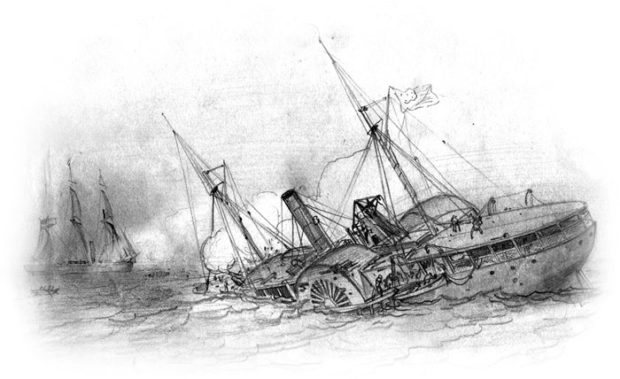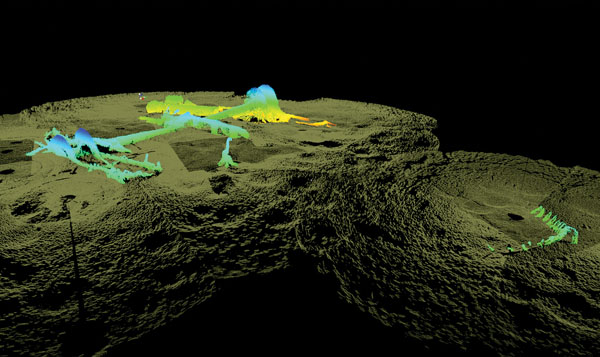Hatteras Exposed
Sonar map reveals new details of sunken Civil War-era warship

A hundred and fifty years ago in January, the U.S. navy gunboat Hatteras was sunk during a battle with the famous Confederate commerce raider CSS Alabama. It was one of the skirmishes that saw the key southern port of Galveston, Texas, change hands twice and remain one of the last bastions of the Confederacy during the American Civil War.
The grave of the iron-hulled steamship is about 20 miles (32km) out from the Texas port city, though she rests in just 57 feet (17m) of water on the sand and silt that once covered the Civil War time capsule. Exposed by storms and the rough and tumble of sand shifting seas, scientists last fall took advantage of the situation to create 3D photo mosaics of the largely intact wreck for research, education, and outreach purposes.
The two-day mission produced a new state of the art 3D sonar map of the site that was released by the National Oceanic and Atmospheric Administration’s (NOAA) Office of National Marine Sanctuaries, ExploreOcean, Teledyne Blueview, and Northwest Hydro. The photographic images show never before seen details of the USS Hatteras, which was the only Union warship sunk in combat in the Gulf of Mexico during the 1861-65 Civil War.

The Hatteras was part of the 1863 West Gulf Blockading Squadron of the U.S. Navy. Under command of Union Rear Admiral David Farragut, the squadron’s role was to block the passage of goods, supplies, and arms to and from the Confederacy on the Atlantic and Gulf coasts.
Out of sight and mind for a century and a half, the Hatteras has now been documented with the 3D imaging technology. “Most shipwreck survey maps are two-dimensional and based on observations made by sight, photographs or by feeling around in murky water while stretching a measuring tape,” said James Delgado, director of maritime heritage for NOAA’s Office of National Marine Sanctuaries. “Thanks to the high-resolution sonar, we have a three-dimensional map that not only provides measurements and observations, but the ability for researchers and the public to virtually swim through the wreck’s exposed remains and even look below the surface at structure buried in loose silt.”

Delgado said the survey revealed that most of one paddlewheel remains intact and that the ship’s stern and rudder are emerging from the sand. The three-dimensional map also plotted damage to engine room machinery and the ship’s paddlewheel shaft, which appears to have bent when the ship capsized and sank after being shot full of holes.
“The engine room spaces were dangerous places in battle,” Delgado said. “Cannon fire severed steam lines and filled these spaces with the scalding vapour. Fires broke out, and yet crew remained at their posts to keep the ship running and fighting, and in there, two of them paid the ultimate price.”
The Hatteras is listed in the National Register of Historic Places and while it is located in federal waters administered by the Bureau of Ocean Energy Management (BOEM) and the Bureau of Safety and Environmental Enforcement (BSEE), the ship itself is administered by the Navy and protected by the Sunken Military Craft Act as a war grave.
Sonar images: NOAA, Office of National Marine Sanctuaries/ExploreOcean. Image by James Glaeser, Northwest Hydro, Inc







